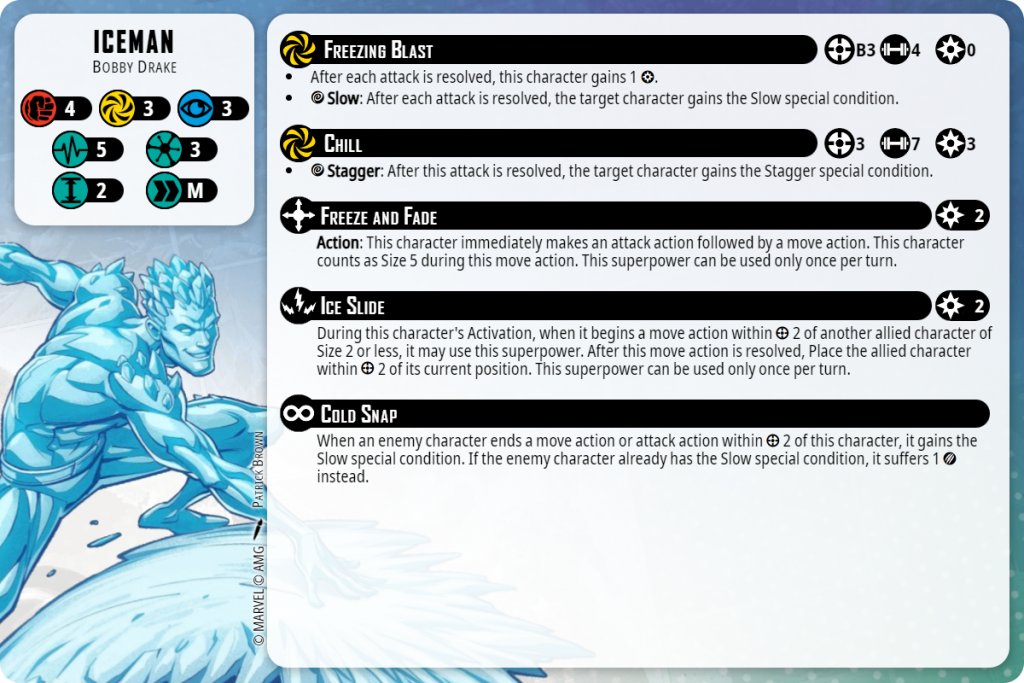All of the original five X-Men have seen significant changes to their character over their history in comics. All of them except for Iceman, until very recently. Up until that point, Bobby was the young, quippy member of the X-Men. If writers didn’t think he needed to change much over 60 years of comics history, why should we care about him, and what role does he play in the larger Marvel Universe? Who is Iceman?
Background
Bobby Drake was born in Floral Park, Long Island, New York. His mutant powers manifested when he was on a date and a local bully tried to take his date away from him. Bobby pointed his hand at the bully and encased him in a block of ice. After news of this incident spread, the town came after Bobby as an angry mob, and Bobby was arrested and placed in a cell “for his own protection.” He is broken out of jail by Cyclops, but refuses to go with him initially. They fight until Charles Xavier intervenes and convinces Bobby to join him at his school after talking with his parents. He then becomes the second member of the X-Men. Hank McCoy, Jean Grey, and Warren Worthington III would join the team after Bobby to form the original X-Men. After several adventures with the original X-Men, Bobby decides to leave the team after being captured by Krakoa. He travels to UCLA and is then abducted by Master Mold, but escapes. With the original X-Men, Bobby forms a new team called X-Factor. He is captured by Loki in an attempt to control the Frost Giants, but is rescued by Thor. After the Muir Island Saga, Iceman along with the rest of X-Factor re-joins the X-Men. After dealing with a ton of acceptance issues with his parents (who do not accept him because of his mutation), Iceman travels back in time with other X-Men to prevent Legion from killing Magneto. However, because of their actions, Legion accidentally kills Professor X, causing a paradox that leads to the Age of Apocalypse.
When Graydon Creed ran for President (on a huge anti-mutant platform), Bobby was chosen to infiltrate his campaign. However, when Bobby’s father speaks out for mutants and the connection between the two is made by the Creed campaign, Bobby is nearly beaten to death, and decides to stay away from the X-Men for a while and stay with his father. After battling through the events of Messiah Complex, Second Coming, and Secret Wars, a younger, time-displaced Bobby Drake is outed as gay by a time-displaced Jean Grey. Younger Bobby confronts older Bobby (who has been in romantic relationships with women in his past) about why he has been presenting straight for his entire adult life. Older Bobby admits that he has been repressing that because of his fear facing prejudice for not only being a mutant, but also a gay man. Older Bobby then decided to be a reserve member of a new X-team led by Kitty Pryde and will be a teacher at Xavier’s school. During a mission with Kitty, she finally confronts him about not telling her about being gay, and convinces him that he needs to tell his parents. Bobby visits his parents for dinner and plans to tell them, but is interrupted by a group of Purifiers, who Bobby dispatches quickly. His parents were angry that their house was destroyed because of him. They later visit him at the X-Mansion, where he comes out to them and they react angrily that he is both a mutant AND gay, and, disgustingly also try to convince him that he is actually straight because of his past relationships. However, Bobby and his father do later reconcile. By this point, his powers had reached Omega-level. During the third annual Hellfire Gala, Bobby is literally melted in front of Kitty Pryde and Romeo by being injected with cellular napalm by Nimrod. Romeo then uses his Inhumans powers combined with his emotional connection to Bobby to restore him back to life.
Publication History/MCU History
Iceman was originally created by Stan Lee and Jack Kirby in 1963. He has had two self-titled limited miniseries, one written by J.M. DeMatteis, and another by Dan Abnett in the early 2000s. He has also appeared in X-Men: The Animated Series (voiced by Denis Akiyama) and in the Fox series of X-Men films (portrayed by Shawn Ashmore).
Recommended Runs
–X-Men #1, #8: I always recommend the first appearance. In issue #8, we also get the first appearance of Iceman in his familiar ice form, instead of the snowy form he had in the beginning.
–X-Factor (1986) #1-6: Iceman is part of a new team and encounters Apocolypse for the first time in these issues.
–X-Men (2004) #207: Climactic final battle of the Messiah Complex story arc that ends with Bobby seeing Professor X getting killed by Bishop.
–All-New X-Men #40, Uncanny X-Men #600: These are the issues where it is revealed that Bobby is gay and his younger self confronts his older self about it.
–Iceman (2017) #1: His first ongoing solo series starts here, and he’s dealing with being out and having Omega-level mutant powers.
Does the Model Miss the Mark?

This is the first model in this series where I have to remind myself that the game versions are snapshots of the comics versions. This is NOT Omega-level Bobby. This is very early Bobby, who wasn’t a powerhouse, which I think is represented well by the fact that he only has a 1 power gainer, Freezing Blast. However, I think AMG has done a good job of translating the version of Bobby that puts his allies in a position to be most effective. He can do this by moving them with his Ice Slide, or by handing out Slow and Stagger conditions to his opponent. He’s also pretty fast with his medium move on a medium-sized base, which can really help him impact multiple points of the battlefield.


